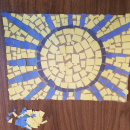Activity: Wear a Toga!
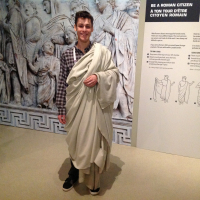
Learn how to step out in style like the ancient Romans did.
Throughout history and across the world, people have used clothing to tell other people something about ourselves. In ancient Rome, a toga wasn’t just for looking fancy, it was also a way of letting people know important details about the wearer’s role in Roman society.
Learning Goals
- Understand the use and importance of togas in Roman society.
- Interpret the use of clothing as a personal statement.
- Analyze how the use of clothing as an indicator of status continues into present-day.
Background Information
In the year 79 CE, the city of Pompeii was buried by the eruption of Mount Vesuvius. Centuries later, archaeologists were able to uncover the remains of a city frozen in time, and the clues left behind on that fateful day build a detailed picture of the daily life of ordinary Roman citizens.
In statues and paintings uncovered in Pompeii, men are shown wearing togas. Though in the 21st century, anyone can wear whatever they want, in the first century, togas were worn by citizens of Rome. In ancient Rome, only men could be Roman citizens. Though life in Rome would have been impossible without the important work done by slaves and working-class freedmen to build and run the empire, and though there were many powerful and important women at all levels of Roman society, they had different rights than a male citizen, and the male citizens showed off their status by wearing a toga.
A toga had a similar function to a suit jacket or blazer today. Togas were worn over a citizen’s regular clothing to important public events, such as games, rituals, or weddings, to show off their social status. A Roman would never go out in a toga and nothing else, any more than you would show up to work or school today wearing only a blazer. The clothing under the toga would usually be a tunic (imagine a giant pillowcase with holes for your arms and head) tied at the waist. In general, the longer the tunic, the higher the status of the person wearing it.
Though women likely also wore togas in earlier times, by the time Pompeii was buried, they wore a long pleated dress called a stola and a shawl called a palla instead. The palla was wrapped around the body in a similar way to a toga, but it was rectangular, could come in many colours, and could be pulled up at the back to cover the woman’s hair when she left the house.
Like all fashion, togas changed over time. For this activity, the toga we’re using as an example was a semicircle of about 5.5 metres of wool fabric, wrapped around the body in a very specific way. It was heavy, hot, and difficult to move in, but an essential item for a Roman citizen.
There were many different types of togas, which include:
Toga praetexta: This toga was white with a purple border, worn by boys until they were old enough to shave (and possibly girls until they were old enough to get married). This type of toga was usually worn together with a pouch-shaped amulet called a bulla. A Roman boy would wear a bulla around his neck to ward off evil. Wealthy or high-born boys would have amulets made of gold, but cheaper versions made of leather were also worn.
Toga virilis: Once the young Roman reached manhood (marked by his first time shaving), the day was usually celebrated with a festival and the young man would trade the toga praetexta for the all-white toga virilis.
Toga candida: If a citizen wanted to run for election, he would bleach his toga extremely bright to stand out from the crowd (the word candida means bright). This is where the modern word “candidate” comes from. If he got elected as a magistrate, he’d wear a toga praetexta again!
Toga pulla: A dark toga worn when someone was in mourning.
Toga picta: Triumphant generals wore the toga picta, or “toga with pictures,” showing off their victories in coloured pictures or gold embroidery. Because purple dye was very expensive, the Emperor would wear a very special toga picta that was all purple with gold embroidery.
The toga was worn by draping it around the wearer in a complex series of folds. It was not supposed to be pinned, since good quality wool would stick to itself and keep the toga in place, but sometimes people might have cheated and used a shoulder brooch called a fibula to help keep the toga in place. A fibula is like an ancient version of a modern safety pin!
Materials
- Fabric (about 5.5m x 1.5m or slightly shorter than your height) OR
- Large bedsheet
- Scissors
- Fabric paint or markers (optional)
- Safety pins or brooch (optional)
Preparation
Decide if you’re going to cut out the toga into the semicircle. If you don’t want to cut up your nice bedsheets, you can come pretty close to the same look using a rectangle of fabric instead!
- Draw a semicircle onto your fabric and cut it out.
- If you want to have a toga praetexta or a toga picta, colour your purple border (on the straight edge) or draw pictures in with your fabric paint or markers.
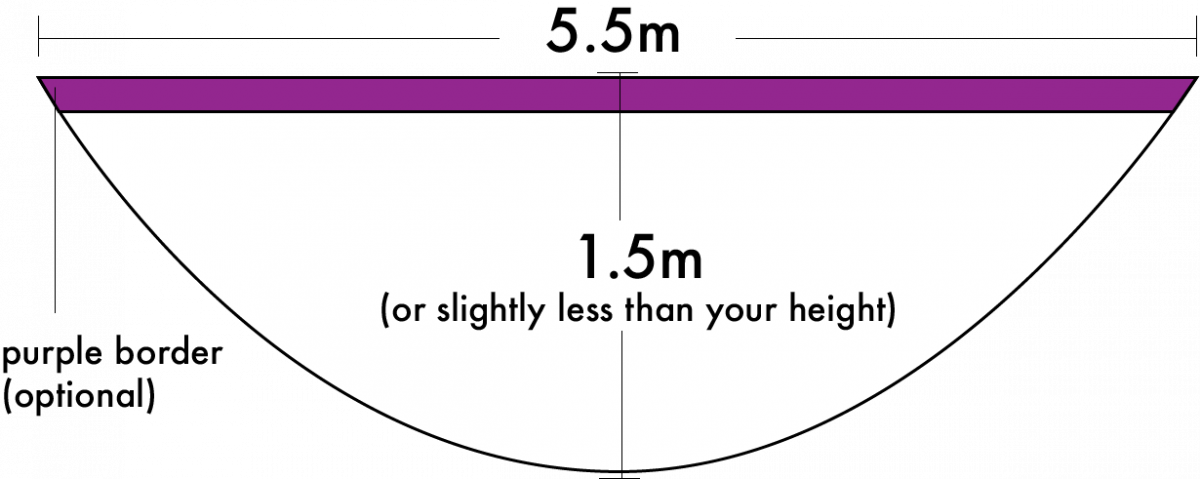
Instructions
Step 1
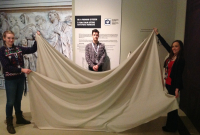
You (or your helper) should start by finding the straight edge of the toga.
Step 2
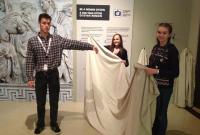
Stand with your left arm straight out to the side.
Step 3
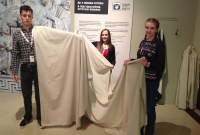
Drape the straight edge of the toga over your left shoulder. Depending on the length of the toga, the end should be around knee length (you may need to adjust this later).
Step 4
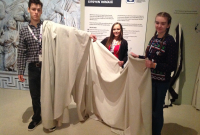
Pleat the toga until your left hand is free.
Step 5
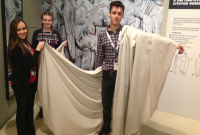
Bring the other end of the toga under your right arm. You might need to use your left hand to hold it in place on your left shoulder during this step.
Step 6
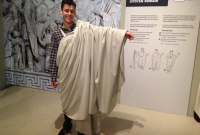
Draw the toga up and drape it over your left shoulder a second time.Add pleats to the toga again until your left hand is no longer covered by fabric.
Step 7
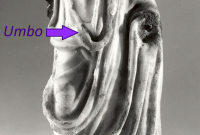
Take the inner layer of fabric going over your left shoulder, and gently pull it out until it hangs over the outer layer of the toga. This is the umbo, which would help keep the toga in place.
Step 8
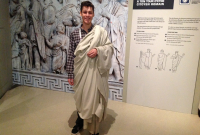
Fold your left arm in toward your body.
Step 9
If any material is trailing behind you, drape it over your right arm or hold it in your hand.
Step 10
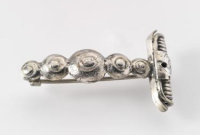
Use pins or a brooch to secure the toga at your shoulder if you need your toga to be extra secure.
Tips
Romans usually had a servant to put on their toga for them. This activity is much easier if you ask a friend or family member to help!
Follow-Up
Discussion prompts:
- What does your toga say about you?
- How does it feel to move around in a toga?
- Why would someone want to wear a garment like this, even if it’s hard to move around it?
- What kinds of social situations do we get more dressed up for today?
-
Why would a Roman citizen want to wear clothing that’s different from non-citizens?
Extension Activities
Look for other examples of Roman clothing in the Online Collections or do extra research to find other types of Roman clothing.
Create an ancient Roman fashion magazine, or try to recreate the clothing to put on an ancient Roman fashion show.


